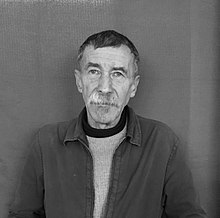Peter McClure was born in Venice. His parents gave him Scottish and Serbian roots. Attended school and devoted himself to the study of art and architecture, Peter has in London. Subsequently, the artist moved to Cornwall. Further stations in his life are Hartlepool on the east coast of England and the Kintyre peninsula off the Scottish coast. In the process, Peter spent many years in artists' colonies. He described his job description at a Buddhist meeting as a wanderer. Peter is fascinated by magic squares, prime numbers and geometry. Geometric art has made the artist famous. McClure sees mathematics as the only universal truth and positions himself critically against illusionistic representations of reality. Peter sees in every painting an abstraction of truth.
After leaving London, Peter McClure concentrated on his artistic pursuits in Cornwall. He began to wander, collecting rubbish as he went. Kurt Switters often used the contents of other people's wastebaskets in his collages. McClure took what others had left behind in nature. Peter sorted his finds in terms of color and textures. The artist then meticulously cut his material into squares and painted some of them. Peter mounted the squares, which were in primary colors, onto a sheet of plywood. He refers to this work as a hybrid, it was neither this nor that. He put the work on consignment for sale and found it there thirty years later. Since that first painting, Peter has moved around a lot and has been extraordinarily productive. The artist has sold, generously given away or simply lost many of his collages, constructions, paintings and drawings. In 2009, the artist took what is probably the most unusual step a painter has ever taken. Peter burned all the works that were in his studio in Cornwall at the time. What remained was a bottle full of ashes, which Peter keeps to this day.
The time Peter spent at the artists' colony in Cornwall was among his most productive periods. The large number of works created there, the artist almost summarizes under the term GOMETRISM. Cornwall is a magnetic attraction for artists, collectors and art moguls. An environment with which the critical artist had to deal. During an exhibition that was part originals and part prints, Peter asked visitors if they could tell which paintings were prints. Many visitors saw no difference and many felt the copies were of better quality. Peter McClure moved to Hartlepool. Local art here receives little national attention. The local artists do not work for awards and fame. They create from the heart and for the love of creativity. Perhaps Peter McClure has finished his wanderings here and arrived.
×





 - (MeisterDrucke-227211).jpg)
 - (MeisterDrucke-227211).jpg)
 - (MeisterDrucke-169298).jpg)
 - (MeisterDrucke-169298).jpg)
 - (MeisterDrucke-226216).jpg)
 - (MeisterDrucke-226216).jpg)
.jpg)
.jpg)
 - (MeisterDrucke-230293).jpg)
 - (MeisterDrucke-230293).jpg)
 - (MeisterDrucke-161880).jpg)
 - (MeisterDrucke-161880).jpg)
.jpg)
.jpg)
.jpg)
.jpg)
_-_(MeisterDrucke-1644254).jpg)
_-_(MeisterDrucke-1644254).jpg)
_-_(MeisterDrucke-1644442).jpg)
_-_(MeisterDrucke-1644442).jpg)
 - (MeisterDrucke-230784).jpg)
 - (MeisterDrucke-230784).jpg)
 - (MeisterDrucke-226195).jpg)
 - (MeisterDrucke-226195).jpg)
.jpg)
.jpg)
_-_(MeisterDrucke-1644154).jpg)
_-_(MeisterDrucke-1644154).jpg)
 - (MeisterDrucke-149010).jpg)
 - (MeisterDrucke-149010).jpg)
.jpg)
.jpg)
 - (MeisterDrucke-177090).jpg)
 - (MeisterDrucke-177090).jpg)
_-_(MeisterDrucke-1643752).jpg)
_-_(MeisterDrucke-1643752).jpg)
 - (MeisterDrucke-269569).jpg)
 - (MeisterDrucke-269569).jpg)
_-_(MeisterDrucke-1644078).jpg)
_-_(MeisterDrucke-1644078).jpg)
 - (MeisterDrucke-218604).jpg)
 - (MeisterDrucke-218604).jpg)
 - (MeisterDrucke-293304).jpg)
 - (MeisterDrucke-293304).jpg)
.jpg)
.jpg)
_-_(MeisterDrucke-1644490).jpg)
_-_(MeisterDrucke-1644490).jpg)
 - (MeisterDrucke-255087).jpg)
 - (MeisterDrucke-255087).jpg)
 - (MeisterDrucke-258254).jpg)
 - (MeisterDrucke-258254).jpg)
 - (MeisterDrucke-220773).jpg)
 - (MeisterDrucke-220773).jpg)
 - (MeisterDrucke-201699).jpg)
 - (MeisterDrucke-201699).jpg)
.jpg)
.jpg)
.jpg)
.jpg)
 - (MeisterDrucke-156483).jpg)
 - (MeisterDrucke-156483).jpg)
 - (MeisterDrucke-278011).jpg)
 - (MeisterDrucke-278011).jpg)
 - (MeisterDrucke-209730).jpg)
 - (MeisterDrucke-209730).jpg)
 - (MeisterDrucke-191069).jpg)
 - (MeisterDrucke-191069).jpg)
 - (MeisterDrucke-270978).jpg)
 - (MeisterDrucke-270978).jpg)
 - (MeisterDrucke-277552).jpg)
 - (MeisterDrucke-277552).jpg)
.jpg)
.jpg)
_-_(MeisterDrucke-1644076).jpg)
_-_(MeisterDrucke-1644076).jpg)
 - (MeisterDrucke-156199).jpg)
 - (MeisterDrucke-156199).jpg)
_-_(MeisterDrucke-391037).jpg)
_-_(MeisterDrucke-391037).jpg)
 - (MeisterDrucke-155210).jpg)
 - (MeisterDrucke-155210).jpg)
_-_(MeisterDrucke-286640).jpg)
_-_(MeisterDrucke-286640).jpg)
 - (MeisterDrucke-230073).jpg)
 - (MeisterDrucke-230073).jpg)
 - (MeisterDrucke-173714).jpg)
 - (MeisterDrucke-173714).jpg)
 - (MeisterDrucke-146156).jpg)
 - (MeisterDrucke-146156).jpg)
 - (MeisterDrucke-268126).jpg)
 - (MeisterDrucke-268126).jpg)
.jpg)
.jpg)
 - (MeisterDrucke-188093).jpg)
 - (MeisterDrucke-188093).jpg)
.jpg)
.jpg)
.jpg)
.jpg)
 - (MeisterDrucke-260301).jpg)
 - (MeisterDrucke-260301).jpg)
_-_(MeisterDrucke-318620).jpg)
_-_(MeisterDrucke-318620).jpg)
 - (MeisterDrucke-258069).jpg)
 - (MeisterDrucke-258069).jpg)
.jpg)
.jpg)
_-_(MeisterDrucke-389248).jpg)
_-_(MeisterDrucke-389248).jpg)
 - (MeisterDrucke-240623).jpg)
 - (MeisterDrucke-240623).jpg)
_-_(MeisterDrucke-1644077).jpg)
_-_(MeisterDrucke-1644077).jpg)
 - (MeisterDrucke-236838).jpg)
 - (MeisterDrucke-236838).jpg)
 - (MeisterDrucke-198224).jpg)
 - (MeisterDrucke-198224).jpg)
 - (MeisterDrucke-219794).jpg)
 - (MeisterDrucke-219794).jpg)
_-_(MeisterDrucke-381436).jpg)
_-_(MeisterDrucke-381436).jpg)
.jpg)
.jpg)
 - (MeisterDrucke-246665).jpg)
 - (MeisterDrucke-246665).jpg)
.jpg)
.jpg)
 - (MeisterDrucke-191415).jpg)
 - (MeisterDrucke-191415).jpg)
 - (MeisterDrucke-194451).jpg)
 - (MeisterDrucke-194451).jpg)
 - (MeisterDrucke-204339).jpg)
 - (MeisterDrucke-204339).jpg)
.jpg)
.jpg)
 - (MeisterDrucke-149030).jpg)
 - (MeisterDrucke-149030).jpg)
 - (MeisterDrucke-157967).jpg)
 - (MeisterDrucke-157967).jpg)
.jpg)
.jpg)
 - (MeisterDrucke-207489).jpg)
 - (MeisterDrucke-207489).jpg)
.jpg)
.jpg)
.jpg)
.jpg)
.jpg)
.jpg)
.jpg)
.jpg)
_-_(MeisterDrucke-317269).jpg)
_-_(MeisterDrucke-317269).jpg)
.jpg)
.jpg)
.jpg)
.jpg)
.jpg)
.jpg)
_-_(MeisterDrucke-381435).jpg)
_-_(MeisterDrucke-381435).jpg)
_-_(MeisterDrucke-1644443).jpg)
_-_(MeisterDrucke-1644443).jpg)
_-_(MeisterDrucke-155064).jpg)
_-_(MeisterDrucke-155064).jpg)
.jpg)
.jpg)
_-_(MeisterDrucke-315602).jpg)
_-_(MeisterDrucke-315602).jpg)
_-_(MeisterDrucke-1036878).jpg)
_-_(MeisterDrucke-1036878).jpg)
_-_(MeisterDrucke-387189).jpg)
_-_(MeisterDrucke-387189).jpg)
.jpg)
.jpg)
_-_(MeisterDrucke-1039815).jpg)
_-_(MeisterDrucke-1039815).jpg)
.jpg)
.jpg)
_-_(MeisterDrucke-286831).jpg)
_-_(MeisterDrucke-286831).jpg)
.jpg)
.jpg)
.jpg)
.jpg)
_-_(MeisterDrucke-387185).jpg)
_-_(MeisterDrucke-387185).jpg)
.jpg)
.jpg)
_-_(MeisterDrucke-188797).jpg)
_-_(MeisterDrucke-188797).jpg)
.jpg)
.jpg)
.jpg)
.jpg)
_-_(MeisterDrucke-1037615).jpg)
_-_(MeisterDrucke-1037615).jpg)
.jpg)
.jpg)






